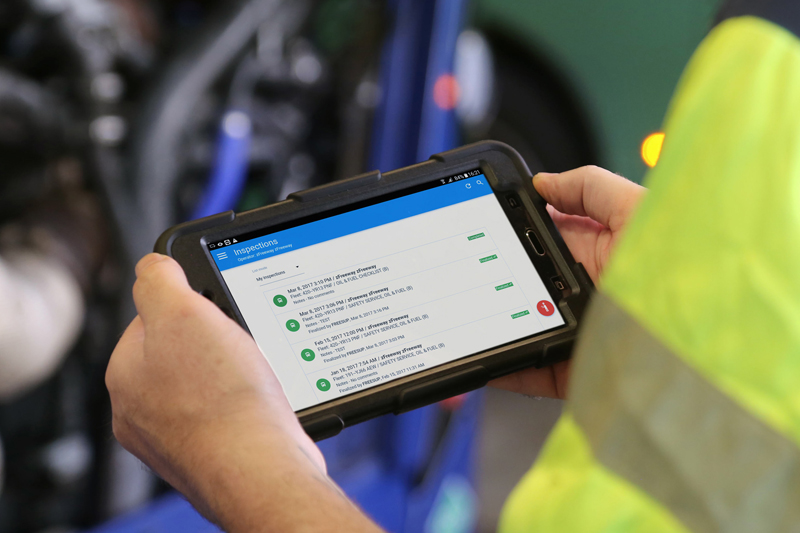
Workshop management can be a tricky balance between minimising downtime and maximising efficient use of resources. There is software available that can help, but where do you start? Sharon Clancy, CVW ’s Consulting Editor, offers some guidance.
Whether you’re operating an in- house workshop or an independent workshop offering maintenance services, computer-based workshop management systems (WMS) are becoming an essential tool. Knowing where to start can be daunting, but expert advice is to focus on those areas of the workshop where doing things electronically can bring the fastest rewards. For many workshops, this will be a no-brainer – removing paperwork and speeding up the invoicing process.
Less paperwork
There’s no denying that vehicle servicing is a big generator of paperwork. Workshops can easily become submerged in a veritable forest of paper. For example, there are invoices from suppliers, store requisition forms, inspection sheets and reports, job cards, and driver defect reports. Workshop management software can eliminate much of this paper mountain; paper worksheets, requisitions and invoices become digital forms, with all the information stored electronically on an app or file.
Faster invoicing
As well as preventing admin headaches in the office, a WMS can also speed up the invoicing process; most can be linked to SAGE or other accounting systems. All the relevant information needed to create the invoice is in the WMS, including parts used, authorisation – if required – and time taken for the inspection or repair. Instead of days between job completion and the customer being sent an invoice, software can be set up to automatically create an invoice once the job card on a vehicle has been signed off.
The invoice can be emailed to the customer with a copy of the relevant inspection sheet, helping to reduce the number of queries and potential delays in payment.

Smarter warranty management
Some, though not all, WMS software will automatically alert the workshop when a part that is still under warranty is replaced. WMS providers such as Trace Systems claim that many fleets still using paper systems often miss out on warranty claims simply because of the time involved in checking through paperwork to confirm when a part was fitted.
WMS software, with warranty management included, will automatically record the date that a part was fitted in the vehicle history file and flag up when it’s replaced prematurely.
Similarly, some WMS have a stores module that provides a virtual indication of what parts are in stock to help ensure necessary parts are available when a vehicle is scheduled for inspection or defect rectification. With many workshops now having reduced parts stocks and preferring to rely on same-day deliveries from their local factor, this advanced knowledge of what parts will definitely be required can help save downtime and for multi-depot fleets with national stockholdings, ensure that the necessary parts are in the correct workshop.
Workshop scheduling
Matching available resources to scheduled work boosts workshop efficiency, and WMS can help workshops do this more effectively by matching capacity and available technician hours.
Digital maintenance calendars help schedule safety inspections and ensure vehicles remain compliant.
Another compliance benefit of a WMS is that driver defect reports can be incorporated in the vehicle records, creating a full picture of defects, their severity and when they were rectified.

Better communication
Many WMS systems are now internet- based, or ‘cloud-based’, meaning that you access the workshop management software via an internet connection. There’s no need to install the software on office computers, so you’re always up to date with the latest modules and version.
Another benefit is that there is no upfront investment in software; users pay on a monthly basis. The systems tend to be mobile, allowing you to start with basic functions, and adds further modules as business and customer demands grow and change.
Vehicle and maintenance records are also stored online, so the information is accessible via a password to anyone who needs to retrieve or view it. Once data is stored electronically, it becomes much easier to share it with others, both internal and external, including fleet customers, outside maintenance contractors, transport management, and compliance authorities such as the DVSA.
Fleet managers can see planned maintenance, meaning they can schedule their resources, and know immediately via email that work has been completed and the vehicle is available again. Fleets can work with several service providers whilst keeping all the essential compliance and cost information in one place.
With all the data in the cloud, vehicle history files are automatically updated, so a fleet is able to demonstrate compliance, if asked by DVSA inspectors.
For external maintenance contractors, pressure from their customers to have easily-accessible, up-to-date 360° view of compliance seems only likely to increase, making investment in an internet-based WMS an essential workshop tool.
How electronic do you go?
The biggest efficiencies are when all workshop admin activities are completed electronically, including those recorded by the technician, such as inspection sheets, job cards and parts issues.
However, that might be a step too far at first, and many systems allow you to adopt this slowly. As with many things in this digital age, younger members of staff may be keener to embrace working with tablets or smartphones than older employees. Nevertheless, you don’t want to lose the experience of those older technicians, so there is a halfway house.
Don’t forget the hardware
Consumer smartphones or tablets are the cheapest option but may not be robust enough to cope with life in the workshop. The biggest dangers for these devices in a workshop scenario are damage caused by drops from a height, or liquid getting into the device. More expensive, ‘rugged’ devices are designed for tough environments. Workshop management suppliers advise workshops not to worry too much about risking consumer devices in the workshops, because the benefits will outweigh the cost of perhaps having to replace a damaged tablet.
One important consideration is screen size; the more information that needs to be displayed, the harder it can be to read on a small screen. Apps for driver defect reporting, for example, are designed to be smartphone-friendly, with drop down scrollable menus and one-touch entry. However, a workshop job card might need flexibility when it comes to inputting information – can it be done on a five inch smartphone screen, or should you choose an eight inch tablet? At the other end of the scale, 10 inch tablets can be bulky, whereas smaller tablets and smartphones can be slipped into a pocket.








